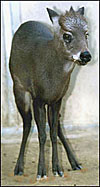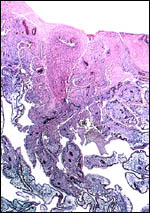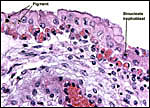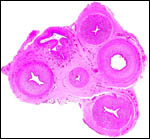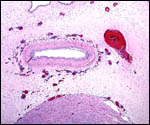|
(Clicking
on the thumbnail images below will launch a new window and a larger
version of the thumbnail.)
|
| Last updated: May 30, 2004. |
Elaphodus cephalophus cephalophus
Order: Artiodactyla
Family: Cervidae (Muntiacinae)
1) General Zoological Data
This is the only member of the genus Elaphodus, a species from Southern China and Burma. It closely resembles the muntjacs in many ways according to Nowak (1999) and other authorities. Elaphodus is contained in the subfamily muntiacinae and three subspecies are recognized (Dolan, 1986). It is one of the most primitive antlered deer. In contrast to muntjacs though, this species lacks the prominent frontal bony ridge. Otherwise, these two species are very similar. Only males carry antlers, in both species. They are smaller in tufted deer although the animals are slightly larger than muntjacs. Their canines are also smaller.
Tufted deer are said to have originated in the Miocene (Dolan, 1971); they separated from muntjacs about 3.4 MYA according to the study of mtDNA by Lan & Shi (1993). Both sexes also bark and are still actively hunted despite their dwindling numbers. Their maintenance in captivity has been described by Schwenn (1988). Adults weigh 17-50 kg and have a single young. These animals are rarely seen in zoos, but the San Diego Zoo has had an active reproductive colony since 1985. The placenta shown here was retrieved from a singleton gestation at term. The longevity of tufted deer is over 12 years in captivity (Jones, 1993).
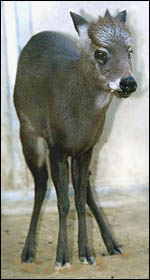 |
Western Tufted Deer at the San Diego Zoo. Notice the small canine tooth and "tuft" of hair. |
The length of gestation is 210 days and the animals usually produce a single young according to Helin & Houji (1982).
3)
Implantation
No early stages of implantation have been described and it is unknown
how many caruncles the uterus possesses.
4)
General Characterization of the Placenta
This was a cotyledonary placenta that weighed 95 g and, remarkably, it
had only two cotyledons, although they were large (9 x 10 x 03 cm and
8 x 11 cm). It is a villous placenta, has an epithelio-chorial relationship
to the mother, and possesses a large allantoic sac.
Since this original description, another full-term placenta of a surviving neonate became available. It appears to have been more complete, as it weighed 400 g and had 5 large, flat cotyledons measuring up to 11 cm in greatest diameters. Its umbilical cord had four large and numerous smaller blood vessels and a large allantoic duct.
The villous structure and general appearance is very much the same as that found in other deer (see chapter on deer). The villi are covered by a single layer of cuboidal epithelium and there are scattered binucleate trophoblastic cells as in other deer. Occasional trophoblastic cells on the villous surface contain a yellow pigment, but the large among of pigment found beneath the chorionic plate in other Artiodactyla is absent. On must assume that the tufted deer have an epithelio-chorial placenta and that the villi were dislodged from the caruncular interstices during detachment of the placenta. No implanted placenta has yet been available.
This specimen's umbilical cord measured 20 cm x 2 cm and was not spiraled. It contained four blood vessels. Approximately 5 cm from the insertion site, between the two cotyledons, the membranes of the allantoic sac meet the amnionic sac. A pair of blood vessels supplies each cotyledon. In the center of the cord is a large allantoic duct that is surrounded by capillaries. Other smaller vessels surround the large arteries and some of the smaller vessels have a musculature. The surface has no areas of squamous metaplasia. The epithelium of the allantoic duct is urothelial.
This is completely unknown.
8)
Extraplacental membranes
The amnion is composed of a thin layer of connective tissue and has a
flat squamous epithelium. No squamous metaplasia was present. The allantoic
sac was attached to the cord near its insertion on the placenta and has
blood vessels. No hippomanes were present.
9)
Trophoblast external to barrier
It is unlikely that trophoblast invades to uterus, but no implanted placenta
has yet been studied.
10)
Endometrium
There is no knowledge on the gestational endometrium. Muntjacs have only
one uterine horn. It is unknown what the situation is for the tufted deer.
Whether there is decidualization of the endometrium in pregnancy is unknown.
11)
Various features
There are no other features of relevance.
12)
Endocrinology
No studies have been published and we have not undertaken endocrine analysis
of these animals.
13)
Genetics
Tufted deer have unusual chromosomes according to the most recent study
of these unusual animals. Shi et al. (1991) found that females had 46
or 47 chromosomes, while males had 47 or 48 chromosomes. In meiotic studies
an autosome/X translocation was identified. Other studies are cited, such
as the one by Zhang et al. (1984) and Wang &. Quan (1981). Hybrids
have not been described. Studies of mtDNA by Lan & Shi (1993) indicated
that muntjacs and tufted deer are closely related.
14)
Immunology
There are no publications on immunological characteristics.
15)
Pathological features
At this zoo we have seen occasional stillbirth without abnormalities.
No significant pathology has been described.
16)
Physiologic data
No studies have been published to my knowledge.
17)
Other resources
Several cell lines of these animals are stored in the "Frozen Zoo"
at CRES
of the San Diego Zoo. They were used in the study by Shi et al. (1991)
and can be made available by contacting Dr. Oliver Ryder at oryder@ucsd.edu.
18) Other remarks - What additional Information is needed?
There is no knowledge on implantation, hormones, accurate length of gestation,
and other reproductive parameters. Few pathologic findings have been made.
Much more knowledge is needed on all these features. An implanted placenta
needs to be studied.
Acknowledgement
The animal photograph in this chapter comes from the Zoological Society
of San Diego. I appreciate also very much the help of the pathologists
at the San Diego Zoo.
References
Dolan, J.M. Jr.: Deer - the successful invaders. Zoonooz (San Diego) 44:4-15,
1971.
Dolan, J.F. Jr.: China's tufted deer. Zoonooz (San Diego) 59:12, 1986.
Helin, S. and Houji, L.: Distribution, habits and resource status of the tufted deer (Elaphodus cephalophus). Acta Zool. Sinica 28:307-311, 1982.
Jones, M.L.: Longevity of ungulates in captivity. Intern. Zoo Yearbk. 32:159-169, 1993.
Lan, H. and Shi, L.: Restriction endonuclease analysis of mitochondrial DNA of muntjacs and related deer. In, Deer of China, pp. 126-134. N. Ohtaishi and H.I Sheng, eds. Elsevier Science Publishers, 1993.
Nowak, R.M.: Walker's Mammals of the World. 6th ed. The Johns Hopkins Press, Baltimore, 1999.
Schwenn, C.: Management and behavior of Western Tufted Deer () at the San Diego Zoo. Animal Keepers Forum 15:475-482, 1988.
Shi, L., Yang, F. and Kumamoto, A.: The chromosomes of tufted deer (Elaphodus cephalophus). Cytogenet. Cell Genet. 56:189-192, 1991.
Wang, Z. and Quan, G.: Karyotype of Elaphodus cephalophus. Zool. Res. 5:78, 1984. (In Chinese).
Zhang, X., Wang, J. and Chen, Y.: Somatic chromosome studies of the tufted deer (Elaphodus cephalophus). Zool. Res. 4:89-93, 1984. (In Chinese).
